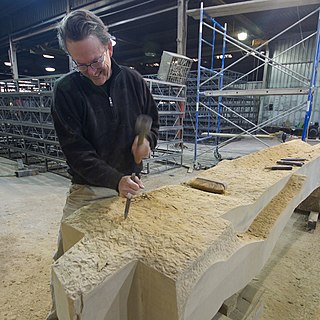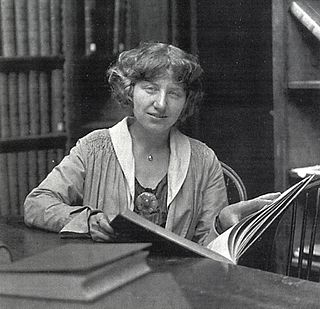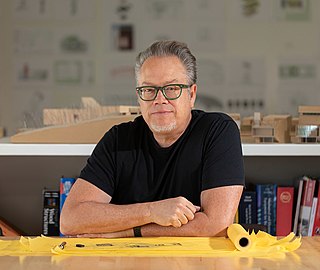
The Miller HullPartnership is an architectural firm based in Seattle, Washington, founded by David Miller and Robert Hull. The firm's major works in the domains of municipal, commercial, and residential architecture reflect a modernist aesthetic and a focus on user needs, geographic context, and ecological sustainability.
Thomas L. Bosworth FAIA is an American architect and architectural educator. His best-known structures are those he designed for the Pilchuck Glass School between 1971 and 1986, but his primary focus in his thirty-five year professional career has been the design of single-family residences across the Pacific Northwest.
Olson Kundig is an American architectural firm based in Seattle, Washington, run by architects Jim Olson and Tom Kundig. Founded by Olson in 1966, the firm’s work has grown to encompass museums, commercial and mixed-use design, exhibit design, interior design, places of worship, and residences, often for art collectors. Olson Kundig was awarded the 2009 AIA Architecture Firm Award from the American Institute of Architects.

Jim Olson, FAIA is the founding principal of the Seattle-based firm Olson Kundig Architects. He is best known for residential design, often for art collectors, though his designs have also included museums, commercial spaces and places of worship. In 2006, William Stout Publishers released Art + Architecture: The Ebsworth Collection and Residence. His honors include the 2007 Seattle AIA Medal of Honor, selection as the 1999 Bruce Goff Chair of Creative Architecture at the University of Oklahoma, and his induction in 1990 as a Fellow of the American Institute of Architects. He is an honorary trustee to the Seattle Art Museum, and a founding trustee of Artist Trust, and Center on Contemporary Art, both in Seattle. Olson received a bachelor of architecture degree from the University of Washington.

Peter L. Gluck is principal of GLUCK+, an architecture firm based in New York City since 1972. A monograph of his work, The Modern Impulse, was published by ORO Editions in 2008. Gluck has designed buildings ranging from structures such as hotels, schools, university buildings and affordable housing to churches, homes, corporate interiors and historic restorations. Many of his projects regularly win national and international design awards and have been published in architectural journals and books in many countries. Gluck's sons are architect Thomas Gluck and director Will Gluck.

2nd & Pike, also known as the West Edge Tower, is a 440-foot-tall (130 m) residential skyscraper in Seattle, Washington. The 39-story tower, developed by Urban Visions and designed by Tom Kundig of Olson Kundig Architects, has 339 luxury apartments and several ground-level retail spaces. The 8th floor includes a Medical One primary care clinic.
REX is an architecture and design firm based in New York City, whose name signifies a re-appraisal (RE) of architecture (X). Seminal projects include the Dee and Charles Wyly Theatre in Dallas, Texas; the Vakko Fashion Center in Istanbul, Turkey; and the Seattle Central Library. The work of REX has been recognized with accolades including two American Institute of Architects' National Honor Awards in 2005 and 2011, a U.S. Institute for Theatre Technology National Honor Award, an American Library Association National Building Award, and two American Council of Engineering Companies' National Gold Awards.

Peter Q. Bohlin is an American architect and the winner of the 2010 Gold Medal of the American Institute of Architects. He is a Fellow of the American Institute of Architects (FAIA) and a founding principal of Bohlin Cywinski Jackson, established originally in 1965 as Bohlin Powell in Wilkes-Barre, Pennsylvania.
Archimania is a collective of architects and designers in the South Main Historic Arts District of downtown Memphis, Tennessee. The collective was founded in 1995 and is led by Todd Walker, FAIA, and Barry Alan Yoakum, FAIA.

Richard Rhodes is an American sculptor, stonemason, entrepreneur, and scholar of stonework worldwide.
LMN is an American architecture firm based in Seattle, Washington. The company was founded in 1979, and provides planning and design services to create convention centers, cultural arts venues, higher education facilities, commercial and mixed-use developments.

Fred Bassetti was a Pacific Northwest architect and teacher. His architectural legacy includes some of the Seattle area's more recognizable buildings and spaces. The American Institute of Architects (AIA) described his role as a regional architect and activist as having made significant contributions to "the shape of Seattle and the Northwest, and on the profession of architecture."

Lutah Maria Riggs was an American architect who worked for several decades in Santa Barbara, California. Born in Toledo, Ohio, she moved with her mother to Santa Barbara after high school, where she returned after receiving a BA in architecture from the University of California, Berkeley. From 1921 to 1930, she worked as a draftswoman for George Washington Smith, and she continued to work as an architect in Santa Barbara until 1980, focusing primarily on residential work. She was the first licensed female architect in Santa Barbara, and the first woman in California to be named a Fellow of the American Institute of Architects.
Johnsen Schmaling Architects is an architecture firm located in Milwaukee, Wisconsin, United States, where it was founded in 2003 by Brian Johnsen and Sebastian Schmaling. The office is located in a former shoe factory in the Brady Street district of Milwaukee. The principals have described their design philosophy as "poetic realism". Johnsen and Schmaling are on the faculty of the School of Architecture & Urban Planning at the University of Wisconsin–Milwaukee.

TenBerke is a New York City, based architecture and interior design firm founded and led by Deborah Berke, who concurrently serves as Dean of the Yale School of Architecture.
John Ronan is an American architect, designer and educator based in Chicago, in the United States. John Ronan FAIA is founding principal of John Ronan Architects in Chicago, founded in 1999.

David Randall Hertz is an American architect, inventor and educator. He is known for his work in sustainable architecture and as an early innovator in the development of recycled building materials.

Bohlin Cywinski Jackson is a United States-based architectural practice that was founded in 1965 in Wilkes-Barre, Pennsylvania by Peter Bohlin and Richard Powell. Bohlin's firm then merged with John F. Larkin and Bernard Cywinski's Philadelphia-based architectural practice, Larkin Cywinski, in 1979. It is recognized for its distinguished portfolio of residential, university, commercial, cultural and government projects.
Bartholomew Voorsanger is an American architect based in New York.

Marlon Blackwell is an American architect and university professor in Arkansas. He is a Fellow of the American Institute of Architects.











